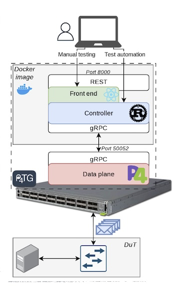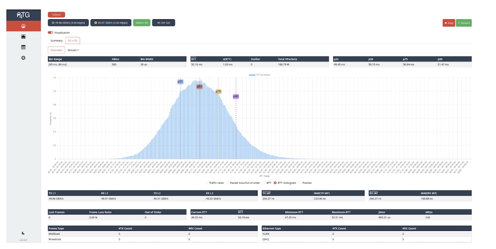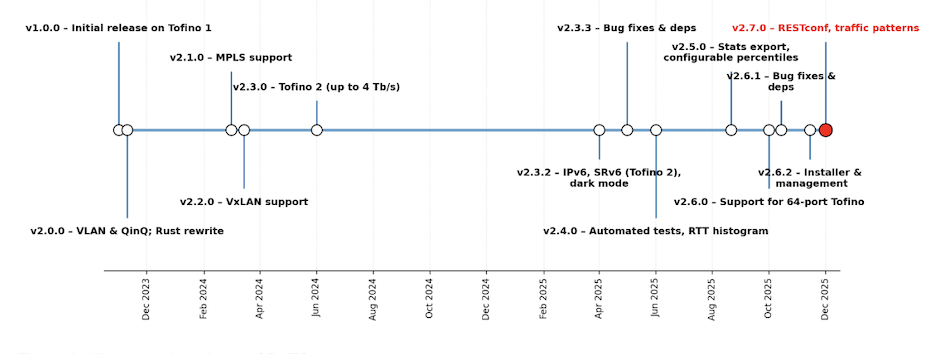Contributed by Fabian Ihle
Modern critical networks increasingly rely on high-performance validation and testing to ensure reliability, resilience, and predictable behavior under load. Traditional traffic generators either depend on software stacks that struggle at high speeds, or on proprietary appliances that are expensive and inflexible. P4TG was developed to bridge this gap.
P4TG is a hardware-accelerated traffic generator and analyzer implemented directly in the data plane of Intel® Tofino™ programmable switches. It combines the flexibility of P4 with the performance of switching ASICs to provide line-rate traffic generation and precise measurement capabilities at terabit speeds. Alongside the data-plane implementation, P4TG includes a Rust-based control plane, a REST API for automated testing workflows, and a web-based frontend for convenient configuration and live visualization, making it suitable for both hands-on lab work and fully scripted test pipelines. P4TG is already used across different industries by telecommunication providers, research labs, aerospace companies and IT companies.
the performance of switching ASICs to provide line-rate traffic generation and precise measurement capabilities at terabit speeds. Alongside the data-plane implementation, P4TG includes a Rust-based control plane, a REST API for automated testing workflows, and a web-based frontend for convenient configuration and live visualization, making it suitable for both hands-on lab work and fully scripted test pipelines. P4TG is already used across different industries by telecommunication providers, research labs, aerospace companies and IT companies.
Flexible Traffic Generation and Protocol Support
P4TG can generate traffic rates of up to 10×400 Gb/s or 40×25 Gb/s. Traffic patterns range from constant bit-rate to Poisson-distributed random traffic, with customizable headers and encapsulations. Packet contents can be adapted per port and per flow to emulate diverse traffic distributions. The platform currently supports:
- Ethernet, IPv4, IPv6 with address randomization
- VLAN, QinQ, MPLS (up to 15 labels)
- SRv6 (on Tofino 2, up to 3 SIDs), VXLAN, and combinations of encapsulations
This allows P4TG to emulate a wide range of realistic deployment scenarios from backbone routers to data center overlays, while maintaining full control over frame structure and traffic distribution.
Integrated Measurement in the Data Plane
Measurement logic is embedded directly into the data plane. P4TG measures traffic rates, round-trip times (RTT), packet loss, out-of-order packets, and frame statistics at high precision. Results are available via the REST API and visualized live in the frontend dashboard during testing.
 Figure 2: The P4TG dashboard with a measured RTT histogram.
Figure 2: The P4TG dashboard with a measured RTT histogram.
Roadmap and Timeline
P4TG was originally developed by Steffen Lindner at the University of Tübingen and is now being further evolved by Fabian Ihle and Etienne Zink. What began as a research prototype has grown into a mature, feature-rich platform with support for modern protocols, automation, and new hardware generations. The roadmap below shows how P4TG continues to advance with more features yet to come.
 Figure 3: History and roadmap of P4TG.
Figure 3: History and roadmap of P4TG.
BDBOS: Bringing P4TG Into a Critical Network Environment
A recent and meaningful adoption of P4TG comes from the German Federal Agency for Public Safety Digital Radio (BDBOS), which operates the communication network used by the government and its administration bodies, as well as emergency, security and rescue services at federal, state and municipal level to communicate securely and reliably at all times across Germany. Ensuring the reliability of this network is not just an operational challenge, it is part of national safety infrastructure.
In their laboratory environment, BDBOS now uses P4TG to simulate realistic high-load conditions. These tests help explore how the network behaves when large amounts of data move between data centers, when thousands of devices connect at once, or when demand spikes unexpectedly.
Because P4TG is cost-efficient, adaptable, and capable of very high bandwidth tests, it complements the commercial tools already in use. Instead of replacing existing systems, it expands the range of what can be tested, especially at the upper end of performance.
References
[1]: S. Lindner, Marco Häberle, and M. Menth: P4TG: 1 Tb/s Traffic Generation for Ethernet/IP Networks, in IEEE Access, vol. 11, p. 17525 – 17535, Feb. 2023, IEEE
[2]: F. Ihle, E. Zink, and M. Menth: Enhancements to P4TG: Histogram-Based RTT Monitoring in the Data Plane, in Proceedings of the 1st KuVS Workshop on Resilient Networks and Systems (ReNeSys) in conjunction with KuVS International Conference on Networked Systems (NetSys), Sept. 2025, Ilmenau, Germany
[3]: F. Ihle, E. Zink, S. Lindner, and M. Menth: Enhancements to P4TG: Protocols, Performance, and Automation, in KuVS Fachgespräch – Workshop on Network Softwarization (KuVS NetSoft), April 2025, Online
[4]: uni-tue-kn. GitHub: P4TG. https://github.com/uni-tue-kn/P4TG
[5]: LinkedIn Post by BDBOS: https://www.linkedin.com/posts/bdbos_bdbos-opensource-p4tg-activity-7385570407245922304-19Uk
